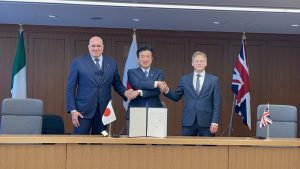On December 14 in Tokyo, the defense ministers of Japan, the United Kingdom, and Italy signed an epoch-making international treaty on the establishment of a joint organization to develop their new sixth-generation fighter jet.
In a joint leaders’ statement in December 2022, the three countries announced their intention to jointly pursue development of a next-generation fighter by 2035, a project know as the Global Combat Air Program (GCAP).
Under the treaty signed today, the three countries will launch a new organization called the GCAP International Government Organization, or the GIGO, during 2024. According to the Japanese Defense Ministry, in total, several hundred government officials from the three countries will be assigned to the organization. It will be headquartered in the United Kingdom, with the first chief executive officer (CEO) coming from Japan.
A similar international organization was established for the joint development of Eurofighter Typhoon jets by Britain, Germany, Italy and Spain.
The treaty marks a key stage of the GCAP, a landmark project that will take more than 10 years to jointly design, develop, manufacture, and deploy the next-generation fighter aircraft.
This milestone came in response to drastic changes in the security environment surrounding all three countries, exemplified by Russia’s invasion of Ukraine and China’s rapid strengthening of its military capabilities, in addition to the United States’ declining influence, especially in the Global South amid the Israel-Hamas war.
The trilateral development of the stealthy next-generation combat aircraft represents the strategic significance of strengthening cooperation in security between Europe and Japan, which share common values such as freedom, democracy, human rights, and the rule of law.
“As our nation faces the most severe and complex security environment since World War II, we must strengthen our deterrence capabilities,” Japan’s Defense Minister Kihara Minoru said at a joint conference. He added, “Continuing to maintain air superiority, which forms the basis of deterrence, is a serious challenge that we must accomplish.”
British Defense Secretary Grant Shapps echoed Kihara’s views.
“The risks and problems from Europe to the Indo-Pacific are clear for all to see. And so it is enormously important that we join together across our nations to produce this kind of security for our skies,” he said.
“The fact that we are here today is for Italy, and I think for all of us, a very important milestone for the GCAP program and at the same time a very strong message, because our partnership is a message to the rest of the world,” said Italy’s Defense Minister Guido Crosetto at the start of the meeting with his counterparts from Japan and the United Kingdom.
“Military technology is diverted to civilian use. Military research also benefits industry,” he added, stressing the potential for technological innovation through the joint development of the new fighter.
Under the plan, the GIGO aims to centrally manage and operate collaboration between the governments of the three countries and the private sector joint venture – which includes Japan’s Mitsubishi Heavy Industries, Britain’s BAE Systems PLC, and Italy’s Leonardo – to ensure smooth implementation of the GCAP. The joint venture will be led by an Italian representative.
Looking ahead, the GCAP will likely face three major challenges over the decade-plus until the fighter’s scheduled completion.
The first challenge is whether it can actually achieve the required performance in the sixth-generation fighter. The Ministry of Defense in Tokyo envisions the next fighter jet to be a manned aircraft capable of instructing a large number of unmanned aircraft equipped with AI technology to detect and attack enemy aircraft.
The next generation fighter would have to be a counter-stealth aircraft that surpasses current fifth-generation fighters (such as the United States’ F-35, China’s J-20, and Russia’s Su-57), which have stealth capabilities that prevent them from being detected by radar. To achieve this, information superiority and high-intelligentization through sophisticated radar and avionics are essential. Furthermore, even if each part of a fighter jet, such as its engines and sensors, has excellent performance, if these parts are working separately, the aircraft as a whole will not be able to demonstrate its high capabilities. A high level of system integration ability is required to combine these effectively.
The second concern is the intensifying competition among the three countries for leadership over the division of development roles. British defense giant BAE Systems, which has a track record of developing fighter jets such as the Eurofighter, and British engine manufacturer Rolls-Royce, which also plays leading role in the Eurofighter, are already moving forward to take the lead.
An official at Japan’s Acquisition, Technology, and Logistics Agency (ATLA) pointed to Japan’s achievements in developing advanced radars and reducing the weight of aircraft, as well as accomplishing integration. Mitsubishi Heavy Industries has already created a prototype for its X-2 Shinshin combat technology demonstrator aircraft.
The third challenge is whether the three countries can mass-produce fighter jets and bring down the unit price sufficiently. The key to this will be exporting to other countries in Europe, the Middle East, and Southeast Asia. However, Japan’s pacifist Komeito Party, which forms a coalition government with the Liberal Democratic Party led by Prime Minister Kishida Fumio, remains cautious about exporting next-generation fighter jets to third countries.
The ATLA official said that exports cannot be made without the consent of all three countries. If there are restrictions on exports of the new fighter, there is a risk that not only Japan’s national interests, but also Britain’s and Italy’s will be harmed.
The next fighter jet will be Japan’s successor to the Air Self-Defense Force F2 fighter jet. This is the first time that the nation has undertaken joint development of defense equipment on such a large scale with a partner other than the United States.
































